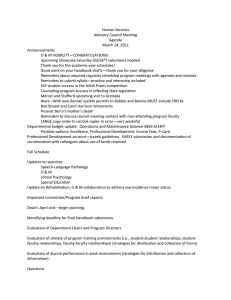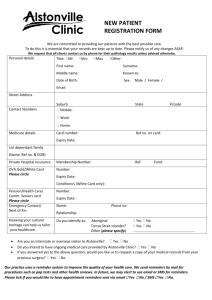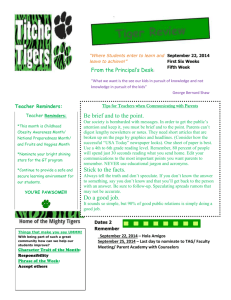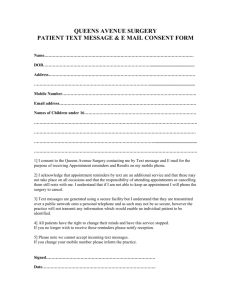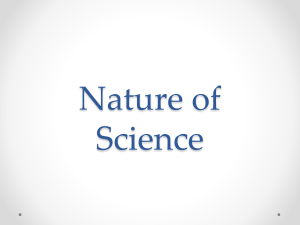Field Experiments for Research and Development in Retail Finance
advertisement
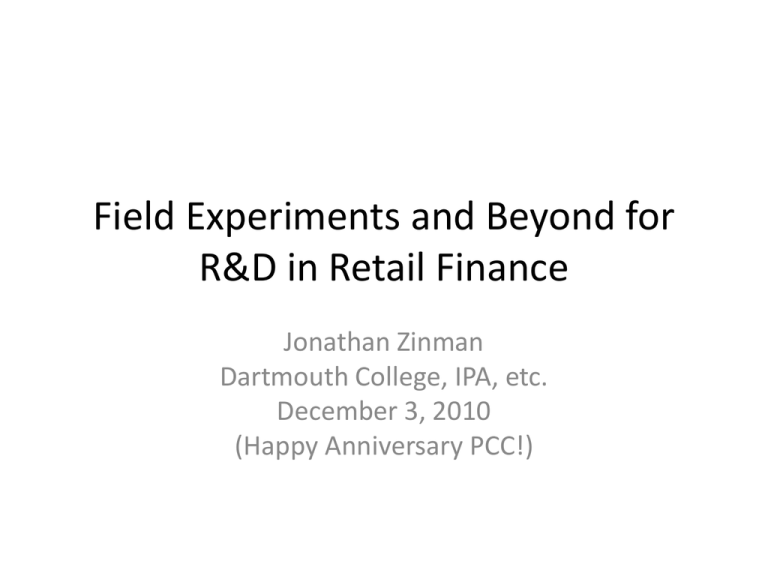
Field Experiments and Beyond for R&D in Retail Finance Jonathan Zinman Dartmouth College, IPA, etc. December 3, 2010 (Happy Anniversary PCC!) An Approach to R&D • Design an innovation based in part on theory and evidence from cutting-edge social science – Product /service development – Product/service features – Pricing (and underwriting) – Marketing – Disclosure – Messaging (feedback and reminders) An Approach to R&D • Design a test of innovation that: – Tests some theory of how markets (don’t) work • Market failure (e.g.., asymmetric information) • *Decision failure (e.g.., limited attention) • Policy failure (e.g., limited enforcement) – Measures impacts of innovation on: • Supplier outcomes (e.g.., profits, client satisfaction) • Client outcomes (account balances, financial condition) – Using randomized/control methods to isolate causal impacts of the innovation An Approach to R&D • Implement tests by tweaking day-to-day operations of a partner – Financial institution – Nonprofit • Evaluate results and make recommendations for strategy, further testing – And sometimes for broader policy, programs Examples • Three examples of R&D motivated by “decision failures” identified in research on “behavioral” decision making: – A new product – A new marketing strategy – A new messaging strategy Product Test Example: Borrow Less Tomorrow • Motivation: for many, highest/safest return investment is… paying down expensive debt • We designed a product that: – – – – helps people make a simple plan to accelerate offers option of enlisting peer supporters sends people reminders about plan and upcoming payment monitors payments and notifies clients (and supporters) when falling off-track • Pilot-tested in Tulsa in early 2010 – 20% take-up rate • without target marketing • without any menu of commitment options – Preliminary and early results on debt reduction looking encouraging Borrow Less Tomorrow: Scalable? • What would product look like at scale? – Payment accelerator algorithm – Menu of commitment options • Performance bonds, “cut me offs” • Goals based on total borrowing, not borrowing anew, etc. – Automated monitoring and messaging • Who has cost advantage for doing this? – Credit bureaus/report-monitoring services – (Online) account aggregators and financial management apps – Credit counseling agencies • What’s revenue model? – Subscription (as part of bundle sold retail, or wholesale) – Performance bond proceeds – Loss-leader for cross-sells Marketing Test Example: Ad Content for Expensive Loans • Setting: payday loan-like market, South Africa • Former, dormant borrowers of large lender • Sent direct mailers with randomized price and advertising content • Ad content had large effects relative to price • Content that increased demand: – triggered visceral/automatic response – not thoughtful/deliberative responses • Scalable? Sure. Lots of opportunities for direct (social) marketing tests. – Take what have learned here and apply to other (more desirable?) behaviors: advice take-up, savings, debt reduction Messaging Test Example: SMS Reminders for Savings Deposits • Setting: 3 mid-sized banks in three different countries, new savings account clients • Test: do (text-message) reminders increases savings account balances? • Method: randomly assign different reminders at account level • Results: – Reminders increase savings by 6% – Mentioning specific goals has incremental effect – Scalable? SMS cheap. Email also worth testing. What Have We Learned? • Can use behavioral economics to: – Change consumer behavior – Improve our research partners’ bottom lines • Have we improved consumer outcomes? Not necessarily. - E.g., do reminders make people save more on net? - Or do people borrow more (expensively) to maintain consumption? • Have we learned enough to inform policy design? – In most cases, not yet… Some Key Questions Going Forward: Outcome Measurement • Critical for policy evaluation • More holistic outcome measurement. Cost is a big issue. Possible solutions: – Online surveys – Develop summary statistics for financial condition – Credit reports – Do research with firms that do client account aggregation! Some Key Questions Going Forward: What Can/Should Policy Do? • What will market do? • Need behavioral theories of market equilibrium with – Complete picture of consumer responses – Given how firms compete for consumers – Subject to regulation under costly enforcement • This is a tall order • Need much more data and theory, much of it nonexperimental, on how: – Behavioral biases relate, fit together, influence outcomes – A behavioral “g-factor”? • Learn from decades of research on intelligence/mental abilities In Meantime • Important to be circumspect about our ability to prescribe good policy based on existing evidence • Lots of potential, as evidenced by ability of small, scalable innovations to change behavior • But: changing behavior not ≠improving outcomes – particularly in equilibrium • Way forward is to continue testing and refining theories about how and why behavior responds
